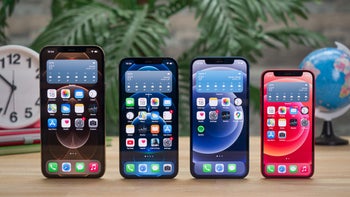Steve Jobs demanded quality, Tim Cook quantity, and iPhone 13 may suffer iPhone 12's fate

Last year, Apple tried to move away from Samsung as an exclusive OLED display supplier by probing LG and BOE but their yield wasn't nearly enough for anything but small batches or repair parts, so Samsung again got the lion's share. Now, however, Apple is apparently confident that LG is finally up to the task, and has ordered 20+ million 6.1" iPhone 12/Pro panels from it.
The 5.4" and 6.7" iPhone 12 mini and 12 Pro Max models, on the other hand, have flexible OLED displays supplied exclusively by Samsung, and with the more expensive integrated touch module that Samsung calls Y-Octa. The 6.1" OLED screen supplies shared with LG, are said to carry an extra touch layer to keep costs down.

That display dis-uniformity, however, may continue on the iPhone 13 as well, tip LG Display analysts when discussing next year's Apple OLED screen plans for The Elec. You see, the current iPhone 12 series models sport LTPS screens, while phones with quality adaptive high refresh rate support have displays of the LTPO variety - think the Oppo Find X2, the OnePlus 8 Pro or, to an extent, the Galaxy Note 20 Ultra - and Apple is planning to switch to LTPO for the iPhone 13 and its high refresh rate, too.
Most important development on the iPhone 13 models from my perspective will be ProMotion with variable refresh rates through LTPO adoption on the Pro models.
— Ross Young (@DSCCRoss) October 2, 2020
The problem, report the industry analysts, is that auxiliary Apple display suppliers like LG may be expanding their LTPO screen capacity to accommodate any iPhone 13 orders, but they may simply not be concurrently ready with the in-cell touch technology that Samsung has mastered by the time they have to be in production.
If this occurs, then Tim Cook will most likely choose to split the four iPhone 13 models into haves and have-nots when it comes to the integrated display touch layer, in order to keep costs down, rather than bet on uniform iPhone display quality as Steve Jobs would have done. Here's the telling industry insider snippet from the iPhone display suppliers interview in the video below:
Han: But if you do all four models next year, that's because only panel makers with technology can supply them. Even if next year is all scheduled to go on-cell [touch], if panel makers aren't ready, some models can go on-cell and some add-on like this year.
Lee: Yes. What the industry is saying is that if it was in the days of Steve Jobs, [Apple] went to strict technical standards and then eliminated all companies that did not meet the standards. By looking at the extent to which these companies respond - LG Display, BOE, etc. - [Apple now] will also consider the company's margin, and adjust it.
In a nutshell, the Apple supply chain insiders are saying that Tim Cook, as a supply chain master, is more inclined to compromise with the iPhone's build uniformity to keep the production costs down which may again result in only Samsung-supplied iPhone 13 displays having integrated touch module. Steve Jobs, on the other hand, would simply source everything only from the company that can do it the way he demands regardless of the extra time or costs involved.
Two different management styles which are somehow both vindicated - the Steve Jobs era for the innovation, and the Tim Cook era for simply making Apple the most valuable company riding on the inspiration. What do you think, are the two CEOs even an apples to apples comparison now?











Things that are NOT allowed: